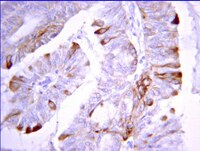PIAS3 activates the intrinsic apoptotic pathway in non-small cell lung cancer cells independent of p53 status.
Dabir, S; Kluge, A; McColl, K; Liu, Y; Lam, M; Halmos, B; Wildey, G; Dowlati, A
International journal of cancer. Journal international du cancer
134
1045-54
2014
Show Abstract
Protein inhibitor of activated signal transducer and activator of transcription 3 (STAT3) (PIAS3) is an endogenous inhibitor of STAT3 that negatively regulates STAT3 transcriptional activity and cell growth and demonstrates limited expression in the majority of human squamous cell carcinomas of the lung. In this study, we sought to determine whether PIAS3 inhibits cell growth in non-small cell lung cancer cell lines by inducing apoptosis. Our results demonstrate that overexpression of PIAS3 promotes mitochondrial depolarization, leading to cytochrome c release, caspase 9 and 3 activation and poly (ADP-ribose) polymerase cleavage. This intrinsic pathway activation was associated with decreased Bcl-xL expression and increased Noxa expression and was independent of p53 status. Furthermore, PIAS3 inhibition of STAT3 activity was also p53 independent. Microarray experiments were performed to discover STAT3-independent mediators of PIAS3-induced apoptosis by comparing the apoptotic gene expression signature induced by PIAS3 overexpression with that induced by STAT3 siRNA. The results showed that a subset of apoptotic genes was uniquely expressed only after PIAS3 expression. Thus, PIAS3 may represent a promising lung cancer therapeutic target because of its p53-independent efficacy and its potential to synergize with Bcl-2 targeted inhibitors. | Western Blotting | 23959540
 |
Death-associated protein kinase 2 is a new calcium/calmodulin-dependent protein kinase that signals apoptosis through its catalytic activity.
Kawai, T, et al.
Oncogene, 18: 3471-80 (1999)
1999
Show Abstract
We have identified and characterized a new calcium/calmodulin (Ca2+/CaM) dependent protein kinase termed death-associated protein kinase 2 (DAPK2) that contains an N-terminal protein kinase domain followed by a conserved CaM-binding domain with significant homologies to those of DAP kinase, a protein kinase involved in apoptosis. DAPK2 mRNA is expressed abundantly in heart, lung and skeletal muscle. The mapping results indicated that DAPK2 is located in the central region of mouse chromosome 9. In vitro kinase assay revealed that DAPK2 is autophosphorylated and phosphorylates myosin light chain (MLC) as an exogenous substrate. DAPK2 binds directly to CaM and is activated in a Ca2+/CaM-dependent manner. A constitutively active DAPK2 mutant is generated by removal of the CaM-binding domain (deltaCaM). Treatment of agonists that elevate intracellular Ca2+-concentration led to the activation of DAPK2 and transfection studies revealed that DAPK2 is localized in the cytoplasm. Overexpression of DAPK2, but not the kinase negative mutant, significantly induced the morphological changes characteristic of apoptosis. These results indicate that DAPK2 is an additional member of DAP kinase family involved in apoptotic signaling. | | 10376525
 |












